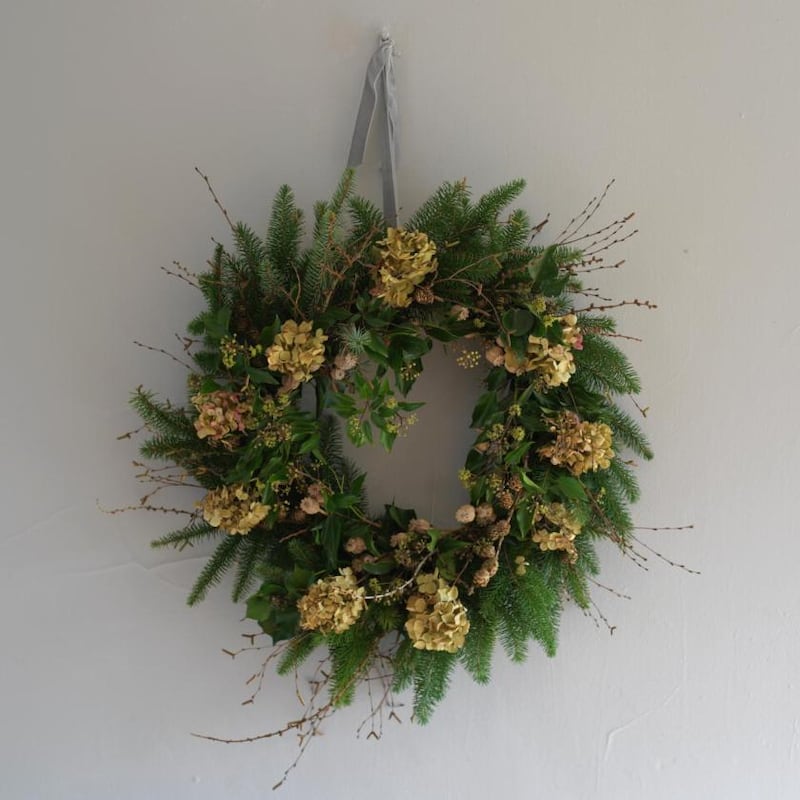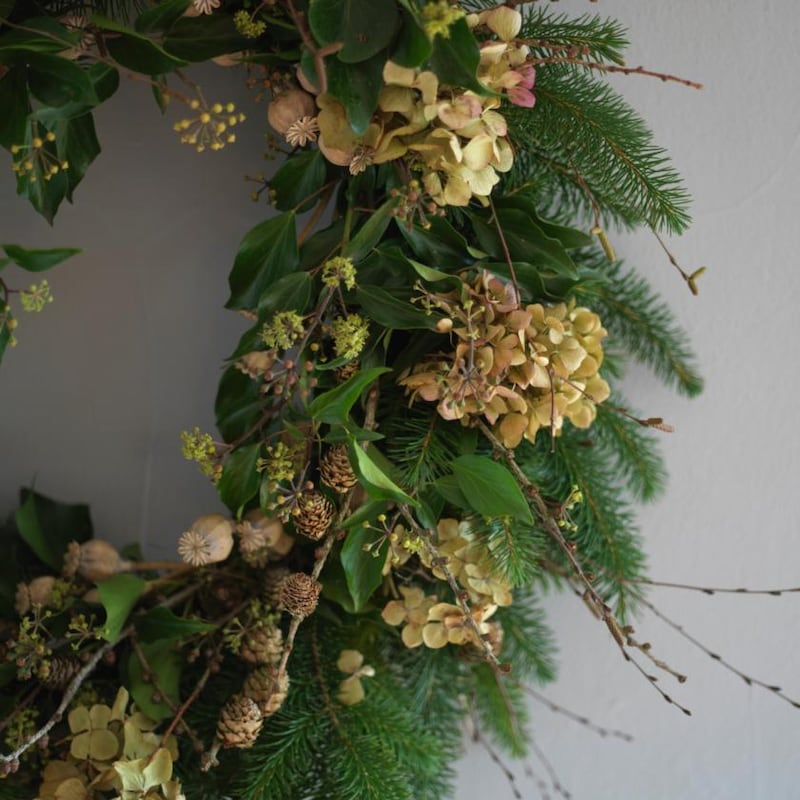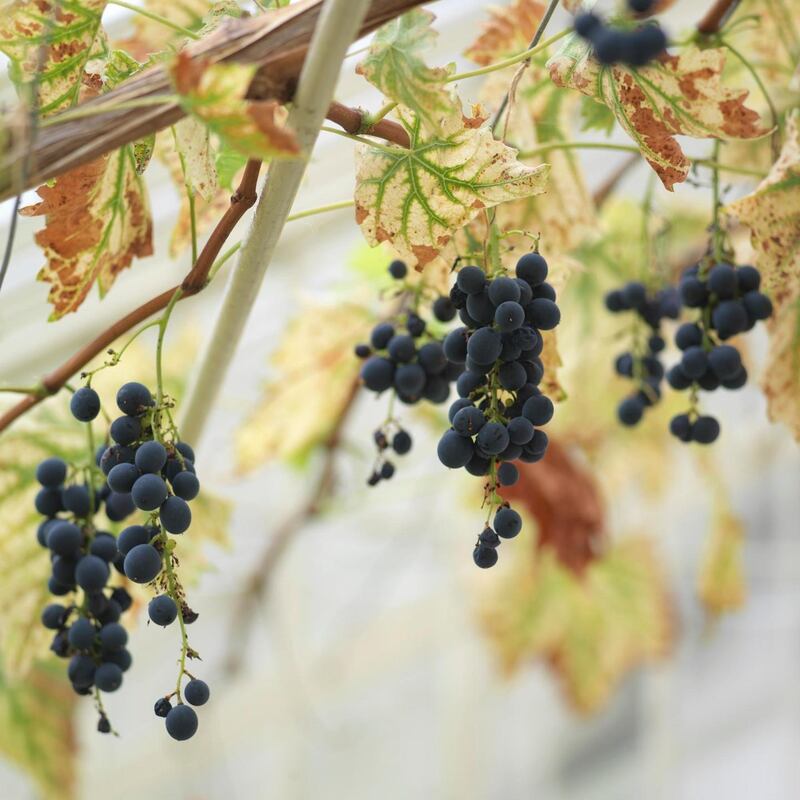There is something about the annual ritual of making a Christmas wreath – those muddy-booted excursions to hunt for foliage, seed heads and berried branches, the last-minute rummage for sharp secateurs, wire and suitable ribbon, the ceremonial assembly of the wreath itself – that I’ll never tire of. Made from natural, locally-sourced, simple, seasonal materials, a homemade wreath succeeds in capturing the magic and symbolism of a proper Irish Christmas in a way that no synthetic, mass-produced wreath ever could. Plus it’s planet-friendly, handcrafted and unique.
So how to make one? I’ve constructed the main circular base from a variety of materials in the past, including young birch twigs, flexible willow wands and even old clematis stems gently twisted into a circle and secured intervals with wire. An alternative is to buy a slim, circular wire frame designed expressly for the purpose (which is what I’ve used for this particular seasonal wreath pictured), while for an dramatically outsized wreath, you could even upcycle an old hula hoop. But whatever you use, try to avoid using those non-biodegradable floral foam rings, which are full of nasty chemicals and plastics, making them as unsustainable as it gets.
Asymmetric wreaths have been fashionable for some years, but if you prefer a full, uninterrupted circle of foliage, then a circular wire frame makes the perfect scaffold
When it comes to different styles, asymmetric wreaths (where only part of the circular base is decorated with foliage/berries/seed heads/feathers/branches) have been fashionable for some years now. These are ideally suited to being created on a partially exposed willow/twiggy base, so that the latter becomes a key part of the finished wreath’s ornamental appeal. But if you prefer the look of a proper evergreen wreath with its full, uninterrupted circle of lush, leafy foliage, then a circular wire frame makes the perfect strong but lightweight scaffold.
You’ll also need, as mentioned, a sharp secateurs and a reel of binding wire. To protect your hands from getting scratched by sharp foliage and branches, a pair of well-fitting gardening gloves is a good idea. If you want to cover the wire base in a damp blanket of moss before adding the foliage, then you’ll also need a generous amount of moss foraged from your garden. While this will help to keep plant material hydrated, I find that natural foliage wreaths last very well without it as long as they’re occasionally spritzed with water and not placed in a warm room.
Last but not least, you need a generous bucket or basketful of seasonal foliage, some twiggy or berried branches plus any ornamental seed heads or dried garden flowers that you may have squirrelled away.
In this particular wreath, I’ve used a simple mix of dried hydrangea flowers, the ornamental seed heads of opium poppies, evergreen conifer branches, birch twigs, larch branches with cones attached and seeded wild ivy, all sourced from the wild or from the garden.



But that’s just a little taster of the range of ingredients that can be foraged from an Irish garden or hedgerow at this time of year. Other examples include berried holly, pittosporum, eucalyptus, rosemary, bay laurel, viburnum, cedar, juniper and ozothamnus, rosehips, sorbus berries, plus the ornamental seed heads of honesty, nigella, teasels and wild clematis.
You could also use less conventional elements including frost-seared ferns, feathers, dried herbs, pampas grass flowers, lichen-covered branches and heather. Some people also like to use a little subtle florist spray to add a splash of seasonal colour, in which case the gentler tones of cranberry, bronze and white are less brassy than gold or silver.
For further Christmas wreath inspiration, have a look at the Instagram feeds of Terri Chandler and Katie Smyth of Worm London (@wormlondon), Scottish-based botanical design studio Pyrus (@pyrusbotanicals) and Utah-based floral designer Nicole Land of Soil & Stem (@soilandstem)
Whichever mix of natural materials you plump for, the real secret to making this sort of ultra-lush and satisfyingly bushy Christmas wreath is rhythm and repetition. The way to achieve that is by making a series of very similar mini-bouquets, each of roughly the same length – I aim for somewhere between 15cm and 20cm, but also allow the occasional twiggy branch to be a bit longer to avoid it looking overly uniform. I also make each mini-bouquet to a similar fullness and using roughly the same mix and ratio of ingredients.
In this particular wreath, for example, each mini-bouquet used is made up of two stems of evergreen coniferous foliage, two stems of ivy, two birch twigs, one larch twig with cones, and three dried opium poppy seed heads. As you make each mini-bouquet, tie one end of it tightly together with a short length of wire and then put it aside until you’re ready to wire it on to the base.
It's quite simple once you get the hang of it. Just remember that the aim is to create a seamless and satisfyingly lush circle while concealing the mechanics
Once you’ve made enough mini-bouquets to comfortably cover your wreath’s wire base, start placing them in position, using the reel wire to secure them very firmly to the frame. Always place them at the same gentle angle and flowing in the same direction (I think clockwise looks best) so that the bushier end of each mini-bouquet reaches out beyond either the outer or inner edge of the circular frame to conceal it. You also need to generously overlap them so that the wired end of each mini-bouquet is completely concealed beneath the bushier end of the preceding mini-bouquet. This might all sound a little technical but in fact it’s quite simple once you get the hang of it. Just remember that the aim is to create a seamless and satisfyingly lush circle while always concealing the mechanics (the frame as well as any reel wire), and you won’t go far wrong.
Once you've finished securing all of the mini-bouquets to the circular frame in a way that creates a satisfyingly shaggy circle of foliage, seed heads and twigs, finish it off with some dried flowers, clusters of pine cones or whatever takes your fancy, individually fixing these into position using short lengths of wire. After that, all that's left to do is to hang it using a generous length of good-quality ribbon (velvet always looks right for a Christmas wreath while it will also tolerate wind/rain more than other materials). Job done. (See hobbyflorist.ie for metal wreath bases and florists' wire)
This Week in the Garden
Check garden structures such as polytunnels, glasshouses, pergolas, arbours, etc, for any signs of damage caused by recent storms. The same goes for garden trees and large shrubs, which may have lost branches/boughs to high winds. If you’re growing large plants in pots and containers, help to prevent them from blowing over in winter gales by grouping them together in a sheltered corner or against a wall. To protect their vulnerable root systems from winter waterlogging, it’s also a good idea to raise container-grown plants slightly up off the ground by placing pot feet under the base.

Grape vines
This is the best time of year to prune grape vines. While commercial growers use what's known as the Guyot system, home gardeners growing grapevines against a wall or under cover generally use what is known as the 'cordon' or 'rod and spur' system. For detailed step-by-step instructions on how to prune both young and established grape vines using this system as well as how to prune container-grown grape vines, (all of which will require follow-on training and pruning in January as well as during the growing season to encourage them to be fully productive), see rhs.org.uk.

Bird feeders
Shortening days, cooler temperatures and dwindling supplies of food in the wild mean that it's really important to keep bird feeders clean and well stocked at this time of year. Recommended suppliers include irishgardenbirds.ie, whose range of quality bird foods is available online for delivery throughout the island of Ireland (postage free over €50). Last Monday also marked the start of Birdwatch Ireland's 30th annual garden bird survey, which runs to the end of February 2019, with the association appealing to the public to participate, especially those living in the midlands and in the west of Ireland. For further details, see birdwatchireland.ie.
Dates for Your Diary
The Garden and Landscape Designers Association has launched Sustainable Garden Design Challenge, its 2019 student and graduate garden design competition. Open to any student or recent graduate (2016-17) of an accredited garden-design, landscape-architecture or horticulture-related course, or landscape-skills training course, on the island of Ireland, the design brief is to design a front and side garden for a semi-detached house that complies with recent guidelines related to sustainable drainage systems applicable to all housing developments in the Greater Dublin Area. The deadline for completed applications is January 19th. See glda.ie or email studentawards@glda.ie to find out more.
Sunday, December 7th (10am-4.15pm): Christmas market at the National Botanic Gardens in Glasnevin, Dublin, with more than 50 craft and food stalls, live choir and a free visit to Santa and his helpers. See botanicgardens.ie.











